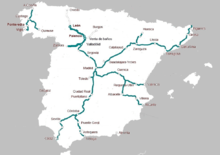Madrid–Levante high-speed rail network

The Madrid–Levante high-speed network is a network of high-speed rail lines that connects Madrid with the Mediterranean coast of the Levante Region, specifically with Castilla-La Mancha, the Valencian Community and the Murcia Region autonomous communities.
The network extends from Madrid to the east, with branches ending in Castellón, Alicante, Elche, Murcia, Cartagena and continuing from Murcia to Almería.
When fully operational the Madrid–Levante network will total 955 km of high-speed rail capable of top speeds of 350 km/h in the majority of its segments.[1]
Segments
| Madrid–Levante high-speed rail network | ||||||||||||||||||||||||||||||||||||||||||||||||||||||||||||||||||||||||||||||||||||||||||||||||||||||||||||||||||||||||||||||||||||||||||||||||||||||||||||||||||||||||||||||||||||||||||||||||||||||||||||||||||||||||||||||||||||||||||||||||||||||||||||||||||||||||||||||||||||||||||||||||||||||||||||||||||||||||||||||||||||||||||||||||||||||||||||||||||||||||||||||||||||||||||||||||||||||||||||||||||||||||||||||||||||||||||||||||||||||||||||||||||||||||||||||||||||||||||||||||||||||||||||||||||||||||||||||||||||||||||||||||||||||||||||||||||||||||||||||||||||||||||||||||||||||||||||||||||||||||||||||||||||||||||||||||||||||||||||||||||||||||||||||||||||||||||||||||||||||||||||||||||||||||||||||||||||||||||||||||||||||||||||||||||||||||||||||||||||||||||||||||||||||||||||||||||||||||||||||||||||||||||||||||||||||||||||||||||||||||||||||||||||||||||||||||||||||||||||||||||||||||||||||||||||||||||||||||||||||||||||||||||||||||||||||||||||||||||||||||||||||||||||||||||||||||||||
|---|---|---|---|---|---|---|---|---|---|---|---|---|---|---|---|---|---|---|---|---|---|---|---|---|---|---|---|---|---|---|---|---|---|---|---|---|---|---|---|---|---|---|---|---|---|---|---|---|---|---|---|---|---|---|---|---|---|---|---|---|---|---|---|---|---|---|---|---|---|---|---|---|---|---|---|---|---|---|---|---|---|---|---|---|---|---|---|---|---|---|---|---|---|---|---|---|---|---|---|---|---|---|---|---|---|---|---|---|---|---|---|---|---|---|---|---|---|---|---|---|---|---|---|---|---|---|---|---|---|---|---|---|---|---|---|---|---|---|---|---|---|---|---|---|---|---|---|---|---|---|---|---|---|---|---|---|---|---|---|---|---|---|---|---|---|---|---|---|---|---|---|---|---|---|---|---|---|---|---|---|---|---|---|---|---|---|---|---|---|---|---|---|---|---|---|---|---|---|---|---|---|---|---|---|---|---|---|---|---|---|---|---|---|---|---|---|---|---|---|---|---|---|---|---|---|---|---|---|---|---|---|---|---|---|---|---|---|---|---|---|---|---|---|---|---|---|---|---|---|---|---|---|---|---|---|---|---|---|---|---|---|---|---|---|---|---|---|---|---|---|---|---|---|---|---|---|---|---|---|---|---|---|---|---|---|---|---|---|---|---|---|---|---|---|---|---|---|---|---|---|---|---|---|---|---|---|---|---|---|---|---|---|---|---|---|---|---|---|---|---|---|---|---|---|---|---|---|---|---|---|---|---|---|---|---|---|---|---|---|---|---|---|---|---|---|---|---|---|---|---|---|---|---|---|---|---|---|---|---|---|---|---|---|---|---|---|---|---|---|---|---|---|---|---|---|---|---|---|---|---|---|---|---|---|---|---|---|---|---|---|---|---|---|---|---|---|---|---|---|---|---|---|---|---|---|---|---|---|---|---|---|---|---|---|---|---|---|---|---|---|---|---|---|---|---|---|---|---|---|---|---|---|---|---|---|---|---|---|---|---|---|---|---|---|---|---|---|---|---|---|---|---|---|---|---|---|---|---|---|---|---|---|---|---|---|---|---|---|---|---|---|---|---|---|---|---|---|---|---|---|---|---|---|---|---|---|---|---|---|---|---|---|---|---|---|---|---|---|---|---|---|---|---|---|---|---|---|---|---|---|---|---|---|---|---|---|---|---|---|---|---|---|---|---|---|---|---|---|---|---|---|---|---|---|---|---|---|---|---|---|---|---|---|---|---|---|---|---|---|---|---|---|---|---|---|---|---|---|---|---|---|---|---|---|---|---|---|---|---|---|---|---|---|---|---|---|---|---|---|---|---|---|---|---|---|---|---|---|---|---|---|---|---|---|---|---|---|---|---|---|---|---|---|---|---|---|---|---|---|---|---|---|---|---|---|---|---|---|---|---|---|---|---|---|---|---|---|---|---|---|---|---|---|---|---|---|---|---|---|---|---|---|---|---|---|---|---|---|---|---|---|---|---|---|---|---|---|---|---|---|---|---|---|---|---|---|---|---|---|---|---|---|---|---|---|---|---|---|---|---|---|---|---|---|---|---|---|---|---|---|---|---|---|---|---|---|---|---|---|---|---|---|---|---|---|---|---|---|---|---|---|---|---|---|---|---|---|---|---|---|---|---|---|---|---|---|---|---|---|---|---|---|---|---|---|---|---|---|---|---|---|---|---|---|---|---|---|---|---|---|---|---|---|---|---|---|---|---|---|---|---|---|---|---|---|---|---|---|---|---|---|---|---|---|---|---|---|---|---|---|---|---|---|---|---|---|---|---|---|---|---|---|---|---|---|---|---|---|---|---|---|---|---|---|---|---|---|---|---|---|---|---|---|---|---|---|---|---|---|---|---|---|---|---|---|---|---|---|---|---|---|---|---|---|---|---|---|---|---|---|---|---|---|---|---|---|---|---|---|---|---|---|---|---|---|---|---|---|---|---|---|---|---|---|---|---|---|---|---|---|---|---|---|---|---|---|---|---|---|---|---|---|---|---|---|---|---|---|---|---|---|---|---|---|---|---|---|---|---|---|---|---|---|---|---|---|---|---|---|---|---|---|---|---|---|---|---|---|---|---|---|---|---|---|---|---|---|---|---|---|---|---|---|---|---|---|---|---|---|---|---|---|---|---|---|---|---|---|---|---|---|---|---|---|---|---|---|---|---|---|---|---|---|---|---|---|---|---|---|---|---|---|---|---|---|---|---|---|---|---|---|---|---|---|---|---|---|---|
| ||||||||||||||||||||||||||||||||||||||||||||||||||||||||||||||||||||||||||||||||||||||||||||||||||||||||||||||||||||||||||||||||||||||||||||||||||||||||||||||||||||||||||||||||||||||||||||||||||||||||||||||||||||||||||||||||||||||||||||||||||||||||||||||||||||||||||||||||||||||||||||||||||||||||||||||||||||||||||||||||||||||||||||||||||||||||||||||||||||||||||||||||||||||||||||||||||||||||||||||||||||||||||||||||||||||||||||||||||||||||||||||||||||||||||||||||||||||||||||||||||||||||||||||||||||||||||||||||||||||||||||||||||||||||||||||||||||||||||||||||||||||||||||||||||||||||||||||||||||||||||||||||||||||||||||||||||||||||||||||||||||||||||||||||||||||||||||||||||||||||||||||||||||||||||||||||||||||||||||||||||||||||||||||||||||||||||||||||||||||||||||||||||||||||||||||||||||||||||||||||||||||||||||||||||||||||||||||||||||||||||||||||||||||||||||||||||||||||||||||||||||||||||||||||||||||||||||||||||||||||||||||||||||||||||||||||||||||||||||||||||||||||||||||||||||||||||||
Madrid–Cuenca–Motilla del Palancar–Valencia
The first 28 km of this 391 km line are shared with the existing Madrid–Seville high-speed rail line. The section onwards to Valencia was inaugurated on 15 December 2010 and entered service on 19 December 2010.
Thirty trains run every day, fifteen in each direction. 22 are non-stop services and eight call at intermediate stations.
Non-stop trains between Madrid and Valencia cover the 391 km (243 mi) in 1 hour and 40 minutes, saving two hours on the previous service of Alaris trains on the classic line.[2]
The line is built to international gauge (1435mm), and electric powered at 25kV AC, with signalling ERTMS levels 1 and 2.
Valencia–Castellón
This segment was inaugurated on 22 January 2018 and is a part of the Mediterranean Corridor. With this extension to Castellón a new AVE service Madrid-Castellón was introduced which cut the journey time between the two cities by further 30 minutes to total 2 hours and 25 minutes.
Four AVE trains per day are scheduled, two in each direction between Madrid and Castellón while this segment is also used by the Alvia service Gijón–Castellón.[3][4]
Valencia–Xàtiva
Segment under construction. Planned for mixed use (goods and passengers).[5]
Xàtiva–Nudo de La Encina
This 41.2 km segment is in service with a maximum speed of 220 km/h.
Motilla del Palancar–Albacete
A 62.8 km segment between Cuenca and Albacete provinces. This section was inaugurated on 15 December and open to the public on 19 December 2010.
Albacete–Nudo de La Encina–Monforte del Cid–Alicante
The 171.5 km section from Albacete to Alicante opened in June 2013.[6]
Monforte del Cid–Elche–Murcia–Cartagena
This segment to Murcia is in service since 2008.
Murcia–Almería
The main purpose of this line is to connect the Transversal Rail Line to the Madrid-Levante and Mediterranean Corridor rail lines. This segment is 184.3 km (108.1 km in Almería Province and 76.2 in Murcia Region).
Stations

Madrid-Atocha
Madrid Atocha (Spanish: Estación de Madrid Atocha, also named Madrid Puerta de Atocha) is the largest railway station in Madrid. Atocha also hosts commuter trains (Cercanías), intercity and regional trains from the south, and AVE high-speed trains to Barcelona (Catalonia) and Seville (Andalusia).
These services are run by the national rail company, Renfe. The station is in the Atocha neighbourhood of the Arganzuela district.
Cuenca-Fernando Zóbel
This new station is 5 km from the city centre. It is named after painter Fernando Zóbel to commemorate his links to the city. The station occupies 3.950 m² with 8.900 m² of parking space.
Albacete
This restored station is 23.000 m² with a commercial area and parking space for 600 cars.[7]
Requena-Utiel
A new 600 m² station was built with parking space for at least 250 cars.[8] It brings the two small towns of Requena and Utiel on to the high-speed map./[2]
Valencia Central Station
A new Valencia Central Station will be built that eventually replaces the existing Valencia North Station. It will be 12 tracks wide in 2 subterranean levels.[9]
Elche-Matola
A 5,500 m² station planned for 2014. With parking space for 500 cars and 50 motorcycles.
Murcia
The new intermodal Murcia del Carmen Station will be close to the present station. It will be 8 rail tracks wide and will serve buses and local trains. [10]
Cartagena
It is yet unclear whether the current train station, located next to the old town, will be the final station for high speed services or a new station will be built on the outskirts of the city. Construction of the high speed railway between Murcia and Cartagena is scheduled to begin in 2018.
See also
References
- ↑ "Líneas de alta velocidad, Línea Madrid - Castilla La Mancha - Comunidad Valenciana - Región de Murcia". ADIF. Retrieved 26 January 2018.
- 1 2 Fox, Brendan (December 2010). "New timetables in Europe". Modern Railways. London. pp. 74–77.
- ↑ Pablo García (22 January 2018). "Una avería para en Sagunto el AVE Madrid-Castellón en su estreno con Rajoy a bordo". El Independiente.
- ↑ JANDRO ROURES (17 January 2018). "Rajoy inaugurará el lunes el AVE Castellón-Madrid que empezará a circular el martes con 4 trenes diarios". elmundo.es.
- ↑ Fed. castellano manchega de amigos del FFCC
- ↑ "High speed to Alacant from June 18". Railway Gazette International. Retrieved 11 June 2013.
- ↑ Nueva estación Vialia de Albacete
- ↑ Nueva estación de Requena-Utiel Archived 2007-10-12 at Archive.is
- ↑ Nueva estación Central de Valencia
- ↑ Murcia Alta Velocidad_Actuaciones Ferroviarias
External links
- AVE at the RENFE (in Spanish)
